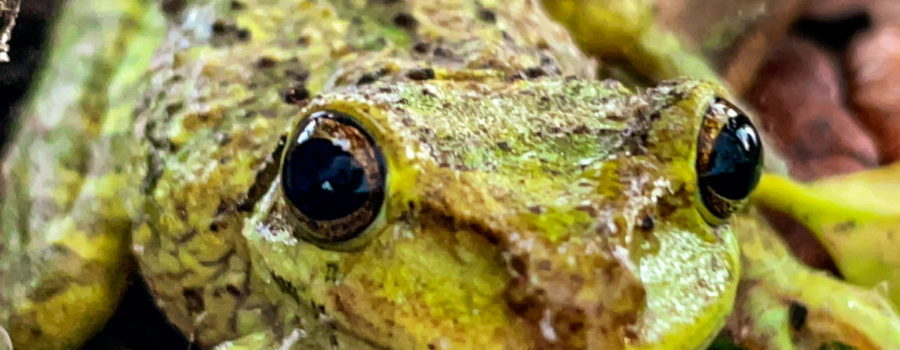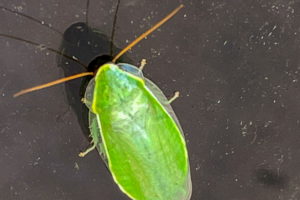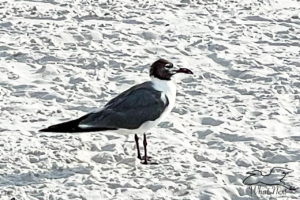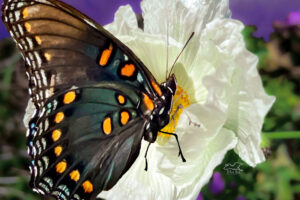The Pine Woods Tree Frog is a Beautiful and Helpful Little Frog

I have seen pine woods tree frogs (Hyla femoralis) around here before, but I don’t see them often since they are mainly arboreal and like to stay in the tops of the trees. I had spotted one back in January, which really surprised me due to the time of year. It was on one of my deck boxes, which seemed unusual to me at the time. Since then I have figured out that it was hunting insects that were drawn to my lighted windows. It was a warm evening, and these guys don’t actually hibernate. They will come out in the winter on warm evenings to feed. That frog was a brownish color phase, the one I saw last week was green, but color aside, you can definitely see the similarities.

Last week, when we came into work, we discovered this little tree frog in our kitchen. I’m not sure how it managed to get in there, but we do see tree frogs outdoors around our facility regularly. It fell on me to catch it and take it outside, which I was happy to do. When I grabbed for the little guy it slipped through my fingers, and I was able to just hang onto one back leg. While that leg was stretched out it was easy to see the orange yellow spots on the back of the leg that this frog is famous for. Once I got the frog outside, we had a little photo session until it decided to go about it way. I didn’t chase it around since I don’t like to harass my subjects too much. The last I saw of it the little frog was headed off into the boxwoods that we have planted around our building.

Pine woods tree frogs are a pretty common tree frog species in the southeastern United States. They can be found mainly in coastal regions from Virginia through Florida and west into Alabama and Mississippi. In Florida they can be found pretty much everywhere except the Keys and the south central portion of the peninsula. They tend to be a solitary species except during mating season and they prefer to live mainly in rural areas. They are also nomadic and don’t tend to establish or defend home ranges. They are most commonly found in pine flatwoods, swamps, marshes, ponds, and wetlands. They will live in dryer areas like our sandhills as long as there is water available in the form of ponds or lakes or roadside ditches. Like other tree frogs they are carnivores and feed on various insects including flies, moths, small spiders including jumping spiders, grasshoppers, ants, and beetles. Many of these species are ones that are considered pests and some of the moths and beetles may cause plant damage. By eating these pests, pine woods tree frogs are very helpful to human beings.

No one knows for sure, but it’s estimated that pine woods tree frogs have a lifespan of 7-8 years. During that time both males and females will breed with multiple partners during any given breeding season. Males attempt to attract receptive females with their calls. Females also indicate their willingness to breed, or the fact that they are done breeding with calls. Those calls can be fairly loud and often remind people of Morse code, so these frogs have the nickname of “Morse code frogs”. The breeding season usually runs from late March or early April through late August. During breeding season the frogs will come out of the tree tops and down to the water in order to mate. Eggs are fertilized externally and are laid on vegetation an inch or two below the water line. The eggs hatch quickly, usually in 2-3 days, and the tadpoles are independent as soon as they hatch. It takes 1 1/2 to 2 1/2 months for them to finish maturing and emerge from the pond as frogs. As you probably know, I am a big fan of frogs, so I was very happy to have this encounter. It isn’t often that people get to see this cute little frog, so every time I do I consider it special.

If you enjoy beautiful nature photography and artwork as well as entertaining and informative content, then this blog is for you. Give us a try by subscribing below.





Recent Comments